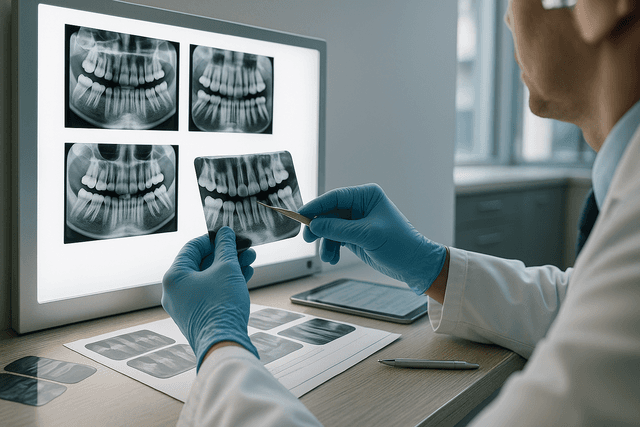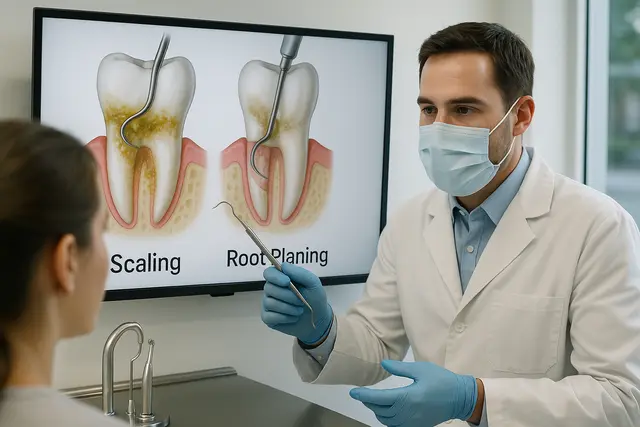General Dentistry
6 min read
Sep 10, 2025
How to Read Dental X-Rays: A Visual Guide to Oral Health Clues
Dental x-rays may look like abstract black-and-white images, but they play a powerful role in uncovering what's really going on beneath the surface of your smile. From detecting hidden cavities to revealing signs of gum disease, these diagnostic tools are essential for maintaining oral health and catching problems early.

Dental x-rays don’t exactly look like something most people want to stare at. They’re grayscale, a bit spooky, and unless you're a dentist, they might as well be cave paintings. But believe it or not, those mysterious x-rays hold the secrets to your oral health. And understanding what you're seeing, or what your dentist sees, can help you stay on top of issues before they turn into toothaches, cavities, or worse.
Ready to become a little more x-ray savvy? Great. Grab your imaginary magnifying glass and let’s explore the inside of your mouth like the pros do.
What Is an X-Ray and Why Your Dentist Swears by It
Dental x-rays (also called dental radiographs if you want to sound extra smart) are images that show what’s happening inside your teeth and gums, basically, everything hidden below the surface. Whether it’s spotting a cavity between your two front teeth or checking for bone loss under the crown, x-rays help your dentist catch problems early.
There are different types of x-ray, including bitewing x-rays (hello, back teeth) and periapical ones that show the full length of a tooth and surrounding bone. In some cases, dentists us digital x-rays or even cone-beam CT scans for 3D views of the teeth and bone. Whatever the type of x-ray, these tools are critical for providing quality dental services and treatment options that actually work.
How a Dental X-Ray Reveals the Truth About Your Teeth
Imagine a dental x-ray as your oral health’s sneak peek. It shows the full story behind your smile, not just what’s clean and shiny on the outside, but what's going on deep down. The enamel, dentin layer, pulp, root canal spaces, root surfaces, even impacted teeth hiding like shy guests in the upper arch.
A healthy dental x-ray usually shows a nice, even shape of teeth and bone, smooth enamel, and no suspicious dark spots. A diseased tooth and bone, on the other hand, will stand out like a sore thumb: irregular shadows, cloudy areas around the teeth, or pockets that indicate decay, infection, or even a cyst.
One reason your dentist may recommend x-rays even if your teeth "feel fine" is because early stages of tooth decay or gum disease don’t always cause pain. Regular dental checkups and dental hygiene cleanings help, but x-rays catch what the toothbrush can’t.
What Your Teeth Are Telling You in an X-Ray
Teeth might not talk, but they do show signs, especially on x-rays. Let’s look at a few telltale clues your dentist looks for:
Tooth decay shows up as dark spots or shadows where the enamel has weakened.
Dental fillings and crowns appear lighter (more opaque) because of the metal or ceramic used.
Cracks or fractures might look like fine lines through the tooth structure.
Missing teeth leave gaps in the jaw. An implant, when present, stands out like a tiny metal post, blending beautifully with your existing dental work.
Bottom line: an x-ray tells your dentist what’s working, what’s lurking, and what needs a fix.
How Gums and Teeth Appear Beneath the Surface
Your gums are more than just the pink part you brush. On a dental x-ray, the area where gums and teeth meet can reveal inflammation, infections, or bone loss. A healthy gum line hugs your teeth tightly, while signs of periodontal disease or gingivitis might appear as receding gums or shadows below the gum tissue.
Gum disease often starts quietly. But left unchecked, it can lead to serious bone loss, affecting the stability of your teeth. That’s why good oral hygiene, brushing, flossing, regular dental cleanings, is your best defense.
Pro tip: lack of flossing can lead to tartar buildup and gum inflammation that show up on x-rays, especially around the teeth near the back.
Gum Disease: X-Rays That Show More Than Meets the Eye
If your dentist spots gum disease on an x-ray, here’s what they’re probably looking at:
Bone loss around the roots of your teeth
Widening of the space between the tooth and bone
Pockets forming where bacteria can collect
Dark spots that might indicate infection or cysts
Gum disease doesn’t always hurt, at least, not at first. But x-rays help catch it early enough to manage it. Periodontal disease can be sneaky, but your dental team is sneakier.
Why You Might Need an X-Ray Even Without Pain
Here’s a not-so-fun fact: some of the most common dental issues, like cavities, early decay, and even cysts, can be totally silent. You could walk into a routine dental checkup feeling fine and still walk out with a treatment plan.
That’s not your dentist being overly cautious. It’s just that x-rays spot what the mirror can’t. The American Dental Association recommends dental x-rays based on your age, risk factors, and oral health history. For most adults, a full-mouth set of x-rays is taken every few years, with bitewings every year or two.
If you’ve ever wondered why they throw a heavy vest on you and leave the room to take x-rays, it’s to protect you from being exposed to radiation, even though modern digital x-rays use much lower doses. Those lead aprons? Still a good idea.
Quality Dental Services Start With Knowing What to Look For
Many dental practices rely on x-rays as a diagnostic powerhouse. From checking the fit of a crown to planning dental implants or uncovering the root of a toothache, dental radiographs are like a roadmap.
They help your dentist:
Track changes in teeth and bone over time
Monitor baby teeth and how adult teeth are coming in
Spot cysts, impacted teeth, or infection in the pulp
Decide if a root canal or other dental treatment is needed
You don’t need to be an expert, but learning to read dental x-rays (with your dentist guiding the way) can give you peace of mind and help you make smarter decisions about your care.
Practical Tips for Reading a Dental X-Ray Like a Pro
While your dentist will always do the heavy lifting, here’s how to spot a few basics on your x-rays:
Enamel looks bright white and dense. Any dark spots on it? Probably decay.
Dentin is just below enamel and slightly less white.
Pulp is the soft center, if you see changes or shadows here, it might mean infection or the start of a root canal problem.
Bone should look even and smooth. Loss or rough edges can suggest gum disease.
Crowns and dental fillings appear bright and clearly shaped.
Cysts show up as darker areas and may need to be watched or removed.
Ask your dentist to walk you through your x-rays during your visit. It's your mouth, after all, you deserve to understand what’s happening inside it.
Help Your Dentist by Taking Good Care at Home
Here’s where the real teamwork comes in. Helping your dentist means sticking to good hygiene habits:
Brush twice a day with fluoride toothpaste
Floss (yes, actually floss) daily to avoid hidden decay and plaque
Eat tooth-friendly foods and avoid constant snacking
Schedule regular dental cleanings and checkups
These little things go a long way in keeping your x-rays boring, and in dentistry, boring is beautiful.
What Do Dental X-rays Show That Regular Exams Cannot?
Dental x-rays reveal hidden details beneath the surface of your teeth and gums that can’t be seen during a visual exam. They help detect cavities between teeth, infections inside the pulp, bone loss from gum disease, cysts, impacted teeth, and even cracks not visible to the eye. This makes them an essential tool for spotting problems early, before they become painful or expensive to fix.
How Can You Tell If a Tooth Has Decay on an X-ray?
On a dental x-ray, tooth decay usually appears as darkened or shadowy areas where the enamel has weakened. Healthy enamel looks bright and solid, while cavities create irregular spots, especially between teeth or near the gum line. Dentists look for these subtle changes to catch decay in its early stages, often before you feel any discomfort.
What Does Gum Disease Look Like on an X-ray?
When gum disease progresses, x-rays often show bone loss around the roots of teeth, widening spaces between teeth and bone, and darker areas that indicate infection. A healthy gum line looks even and tight against the teeth, while periodontal disease can create irregularities or pockets. X-rays allow dentists to track these changes and treat gum problems before they cause tooth instability.
Why Are Dental X-rays Needed Even Without Pain?
Many dental issues, like small cavities, early gum disease, or cysts, can exist without causing pain. X-rays help uncover these silent problems so treatment can begin before they worsen. That’s why dentists recommend routine x-rays at regular intervals, often every 1–2 years for bitewings and every few years for a full-mouth set. Even if your teeth feel fine, x-rays ensure your oral health stays on track.
Read Next
Related Posts

General Dentistry
How to Stop Nerve Pain in Tooth: Fast Relief That Works
Tooth nerve pain can be one of the most intense and disruptive types of discomfort. It often strikes without warning and makes everyday activities like eating, drinking, or even talking feel unbearable. Understanding what causes this pain and how to manage it effectively is key to getting fast relief.
4 min read
Sep 15, 2025

General Dentistry
Can a Sinus Infection Make Your Jaw Hurt? Understanding the Connection
Jaw pain can be unsettling, especially when it seems to appear out of nowhere alongside a stuffy nose or headache. Many people are surprised to learn that sinus infections can cause discomfort that feels like it’s coming from the jaw. Understanding the connection between your sinuses and jaw pain is key to getting the right treatment.
5 min read
Sep 15, 2025

General Dentistry
What Is SRP in Dentistry? A Complete Guide to Scaling and Root Planing
When it comes to dental health, most people think regular cleanings are enough to keep their smile safe. But sometimes, what’s happening below the gumline needs more attention. Scaling and root planing (SRP) is a treatment designed to address gum disease at its source, protecting both your gums and teeth from long-term damage.
5 min read
Sep 10, 2025
Don’t have time to research every dentist around you?
See why 30k+ patients trusted us